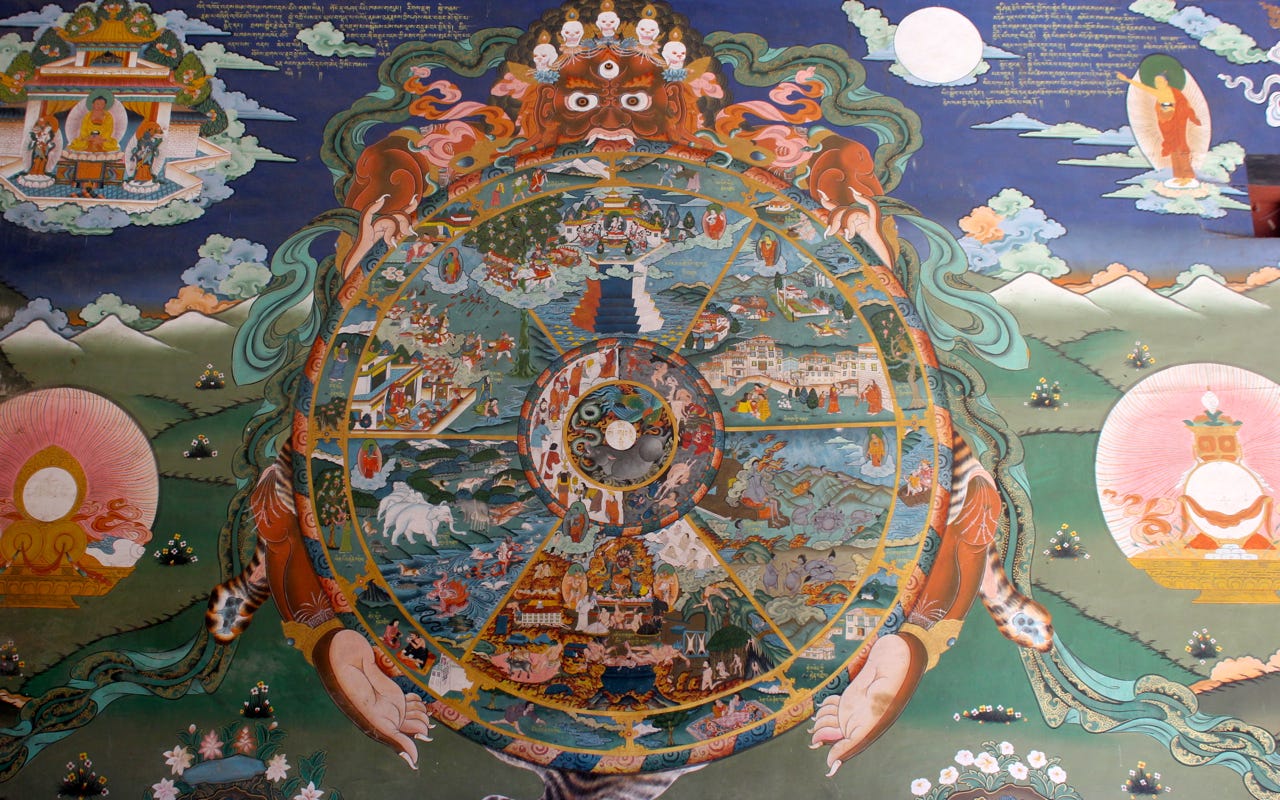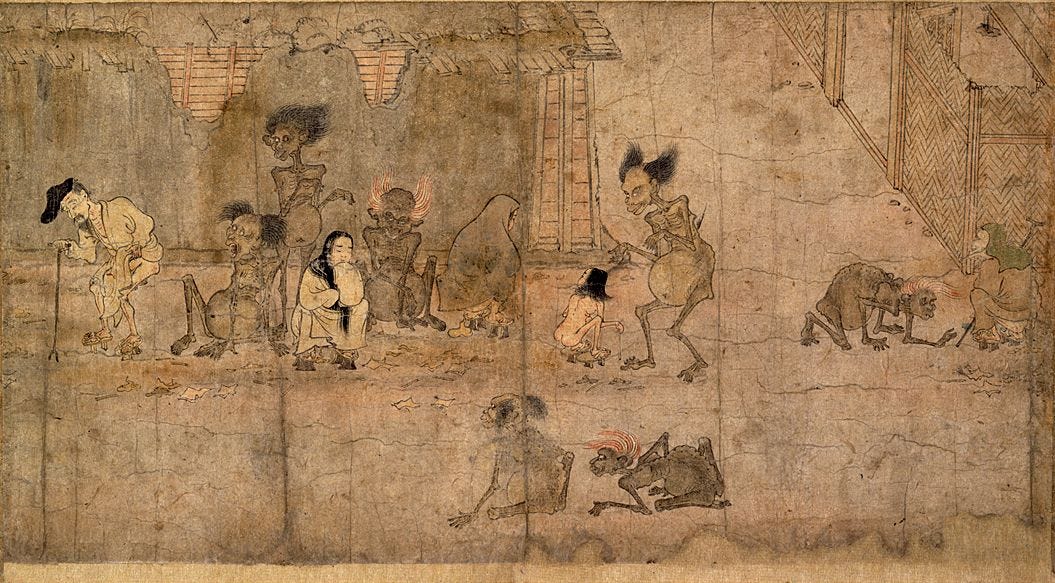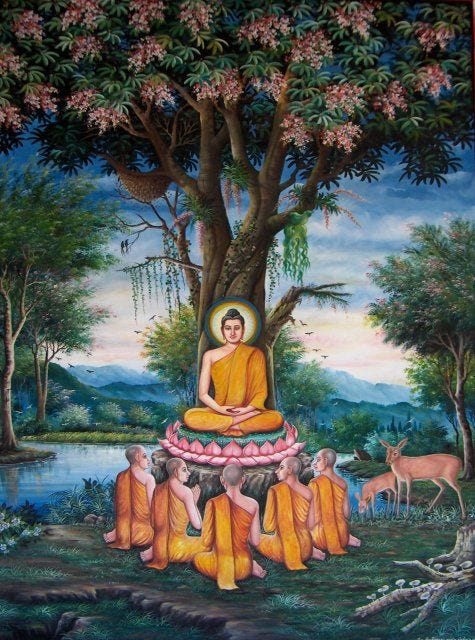Buddhist Realms of Rebirth
A few years back, I met a shaman (we’ll call her Sky Shaman) while on a layover in Europe. We spoke at great length during our flight to Boston, largely about life and death. Sky Shaman, drawing on Native American tradition, consistently described the transitional phases of life as processes of death and rebirth. To the shaman, life is full of more cyclical processes than an analog watch.
At the time, I was also exploring the Six Paths of rebirth in samsara—one of the most oddly abstract yet grounded ideas I’d encountered. The Six Paths are the six possible realms of rebirth one attains after finishing their dying process, and are to be taken literally or metaphorically depending on the Buddhist sect. Today, we are going to discuss the Six Paths from both worldly and cosmological perspectives, while taking to heart the shamanic emphasis on life’s many deaths and rebirths.
A quick note here: I will be discussing psychological and spiritual growth as one process in this piece. I believe them to be one and the same. The ultimate point of growth is reaching the place outside of this cycle: Nirvana. Okay, let’s begin!
Hell (Naraka) Realm
The Hell realm is the place of ultimate suffering.
From the metaphysical perspective, it’s what you’d expect Hell to be. There are numerous Hell realms, some freezing, some scorching hot. The air needs to be conditioned either way, and it sucks.
One lovely thing about the Buddhist perspective on Hell—which is pretty standard for pre-Christian concepts of Hell—is that it’s a temporary place. In samsara, nothing is permanent, and there’s always a death-and-rebirth process in your future—once you’ve worked out the karma that landed you there.
The karmic activity that lands you here is fueled by hatred, violence, and cruelty.
Think of a time you or someone you know made a horrible bed and had to sleep in it. People who have destroyed themselves in the process of destroying others. Many often struggle to feel bad for those in Hell, but Hell’s residents aren’t completely pity free—they do plenty of feeling bad for themselves. People in Hell are so hateful, so angry, that they’re generally isolated in their lives.
The biggest thing holding these people back from progressing is that they’re in such a heavy cocoon of their own suffering, metamorphosing in their pain, that they don’t have much of a chance to grow.
Hungry Ghost (Preta) Realm
The Hungry Ghost realm is for the insatiable.
From the metaphysical perspective, we’re talking about actual ghosts with tiny mouths, huge stomachs, and appetites that can never be satisfied. The appetites we’re discussing include your standard hunger and thirst, but also other cravings.
Beings wind up as hungry ghosts when their karma is shaped by greed-driven behaviors and severe attachment.
Hungry Ghosts, on the psychological level, are people who live their lives trying to scratch their itches to no avail. A hungry ghost may be someone who wants love but can’t accept it no matter how it’s conveyed, or who feels they just need more sex to fill the void in their heart, or who just needs one more drink.
These people are also preoccupied with the hunger itself; the void is more the focus than what fills it, which adds another layer to their suffering. Hungry Ghosts identify as starving—therefore, it’s the starvation that is crucial to their identity.
These people are hindered by their pursuit of satisfying their appetites—a distraction with no resolution.
Animal Realm
The Animal Realm is for those mindlessly living on full automatic.
Animals, as any pet owner will tell you, are ruled by instinct informed by ignorance and fear. Those who are reborn as animals are constant victims of predation and exploitation due to their lack of understanding. Animal rebirths are the result of karma rooted in ignorance and delusion.
From the psychological side of this realm, you have people who go through the motions, never understanding why things happen the way they do. The reasons for their circumstances are generally of little interest to those in the Animal Realm, and they don’t ponder how to change them. People in the Animal Realm lack the insight to pull themselves out of difficult situations, as well as the capacity for true moral and intellectual growth.
Human Realm
The Human Realm is a place of balance.
From the metaphysical perspective: You are here. Congrats, human!
It’s a place of pleasure, of suffering, of wisdom, of ignorance, and the result of good and bad karma. This place is a trip and is accepted to be the most fortunate of all births. It may not be the most pleasant realm, but it provides the most opportunity to break free from the cycle and achieve enlightenment.
Psychologically, if you find yourself in a pursuit of wisdom and truth while battling your ignorance and attachments, you are in the Human Realm. Welcome, babe. The goal now is to make the absolute most of it and pursue liberation with everything you’ve got.
Demigod (Asura) Realm
Demigods are people who have a great deal but are jealous and resentful of those with more.
From the metaphysical perspective, they’re a race of rageful titans that are in active conflict with the devas, or gods (next realm). In Buddhist cosmology, there is a mountain called Mount Meru, which is the axis of the universe. The jealous demigods live at the bottom, while the devas live above in the Heavenly realms. The demigods are largely defined by their envy of those living above them—despite having more than most could ever want—and their ambitious drive to have what the devas have.
The karma that lands one as a demigod is generally a mix of good deeds and prideful or aggressive motivations. As karma is created by both action and intention, you can see where doing the right thing for the wrong reasons might leave you.
Demigods in our world would be the millionaires who hate billionaires. People who are doing just fine but cannot grapple with others having more than them. This isn’t a Hungry Ghost situation; Hungry Ghosts have a hole they cannot fill. Demigods would be perfectly happy if there were nobody with more than them.
The biggest hindrance for the growth of demigods is the jealousy and endless conflict with those they envy. They can't find true happiness and joy within themselves because they keep looking at others.
Heavenly (Deva) Realm
Heaven is awesome, and it’s largely populated by those who’ve earned it.
From the metaphysical perspective, the Deva Realm is atop Mount Meru. Those in Heaven experience a blissful life of pleasure and peace. Nothing is wrong in Heaven. It’s the only realm without suffering, and I assume the air conditioning is perfect. It’s still samsara, and everyone’s time there will end at some point, but it’s a delightful arrangement in the meantime—which is kind of a problem.
Yes, it’s a wonderful place populated by those with a fantastic karma credit rating due to generosity, virtue, and meditation, but it leads to stagnation. Nobody feels the need to make any spiritual progress. By the time they die and switch realms, little to no progress is usually made.
In our world, you would liken this to people who have absolutely fantastic lives and never faced a day of hardship. You know these people. You may want to shake these people. These people, though generally lovely, haven’t had nearly as many growing experiences as most.
Why would they even feel the need to? What context would they have for understanding why growth and development matter?
Death and Rebirth
Over the course of my life, there have been many chapters, often seeming like they couldn’t possibly be from the same lifetime. I’d guess you’ve experienced similar; who you were then would be shocked to see where you are now, I’m sure. And I’m also sure that the transitional phases between those chapters of your life were oftentimes quite painful.
Sky Shaman described those painful transitions as life’s small deaths. When things burn down and new things bloom, our external lives aren’t the only things that change; it’s time to look inward. Take stock of who you were in the previous chapter, and who you’re becoming.
If we take full advantage of the deaths in our lives, we can guide ourselves into more deliberate rebirths—turning tragedy and change into opportunities for wisdom and healing.
The Way Out
Once you’ve taken stock of where you’re existing, where you’re preoccupied and limited, you can figure out the path to liberation.
The place outside of the six realms is an existence of internal peace that cannot be shaken by external circumstances. Buddhists call this Nirvana, and it’s accessible to all. Here at the Station, we call it Home.
The main Buddhist frameworks for liberating yourself are known as the Four Noble Truths and the Eightfold Path.
The Four Noble Truths are the premise upon which the Sakyamuni Buddha’s teachings are built; the Eightfold Path is the methodology for overcoming these realities. These teachings are so central to Buddhism that they were the subject of Sakyamuni Buddha’s Deer Park sermon, the very first lesson in Buddhist history.
Just know that these are very basic views of the teachings. Different schools have differing perspectives, and there are even subsections to these lists. I am simply introducing the concepts for now—we can get more in-depth some other time.
The Four Noble Truths, though translated in many different ways, are essentially this:
1. Life has an inherent quality of suffering.
2. Suffering comes as a consequence of psychological clinging.
3. Liberation from suffering through the cessation of clinging is possible.
4. The way out is through the Eightfold Path.
The Eightfold Path, in an oversimplified fashion, is this:
Wisdom (Prajna):
Right View: Understanding the Four Noble Truths and the nature of reality, including the impermanence of life and the law of karma.
Right Intention: Cultivating thoughts free of ill will, cruelty, and attachment. This involves setting intentions based on kindness, compassion, and renunciation.
Ethics (Sila):
Right Speech: Speaking truthfully, avoiding gossip, lies, and harmful words.
Right Action: Living ethically, refraining from harming others, including abstaining from killing, stealing, and sexual misconduct.
Right Livelihood: Choosing a profession that aligns with ethical principles and avoids causing harm (e.g. professions that involve killing or exploitation).
Mental Discipline (Samadhi):
Right Effort: Cultivating positive states of mind while abandoning unwholesome states like greed, hatred, and delusion.
Right Mindfulness: Being fully present and aware of thoughts, emotions, and actions in the moment.
Right Concentration: Developing focus and meditative absorption (samadhi) to achieve deeper states of clarity and insight.
These teachings are prescriptions, not commandments. If you’re not ready to let go of what you’re grasping, that’s understandable. These are called practices for a reason. Mastery doesn’t come overnight—usually not even in a lifetime. But for those who find they can’t get what they need in pleasure and are tired of pain, perhaps these teachings may be what they’ve been looking for.
I’m not saying the Buddhist method works for everyone. But I find it worth investigating. In the many deaths and rebirths we experience, be they physical or metaphorical, there are struggles to be found in every incarnation.
I would assume that you suffer in some capacity. I know I do. I know my friends do. My family does. My dog did.
Being a person is a lot. Being is a lot. If life is constantly shifting and nothing is permanent, I recommend finding a practice that brings you internal refuge. Turn your mind into a shelter from the turbulent nature of existence and learn to laugh through the storm.
No matter which realm you exist in, there are struggles to be found, but also the path out—the path inward.








thank you!